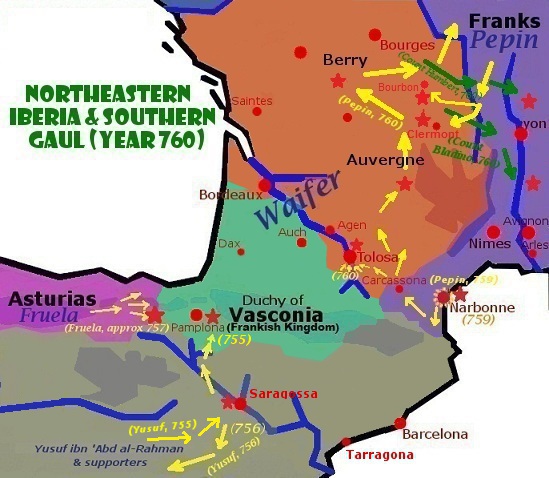Adolescence
Odo’s son Hunald I continued his father’s efforts for independence refusing to recognize the high authority of Charles Martel with the latter marching south of Loire again & seizing Bordeaux in 736. Eventually Hunald was allowed to keep Aquitaine after pledging loyalty to the Frankish overlord. Aquitaine’s compliance would only stand until Charles Martel’s death in 741 when Hunald declared war once more against the Franks. After 4 years of an uneven contest, Hunald would plead for peace in 745. He then appointed the Duchy to his son Waiofar ( the last independent Duke of Aquitaine) & retired in a monastery until his death. Waiofar struggled for some years until he finally succumbed to the Frankish superiority putting an end to the pursuit of national independence.



In the beginning of 778 Charlemagne, King of the Franks after the year 768, appointed his own counts in the major cities of the bordering lands of Vasconia along the banks of the river Garonne (Bordeaux, Toulouse, Fezensac), undermining that way the power of the dukes of Vasconia. Despite the political separatism the city of Bordeaux had adopted Christian rules & Frankish Bishops, with Basilicas, churches & monasteries organized accordingly. The city & its counts, which after 852 belonged in the line created by Ranulf I (Count of Poitiers from 835 and Duke of Aquitaine from 852) had to face several raids from Viking warriors who spread havoc in the wider area during the 9th century killing many of its citizens, including some of its counts.


The city of Bordeaux was shared between the Duchy of Aquitaine & the Duchy of Gascony until it became the exclusive property of the first in 1032 after Sancho VI William Duke of Gascony died without an heir. The House of Ramnulfids or Poitiers would firmly rule in Gascony & Aquitaine during the 11th century in what was defined as the Angevin Empire that stretched beyond the boundaries of France & was ruled as an independent & powerful medieval realm. The empire would stand until the Duchess of Aquitaine, Eleanor, sole heiress of the Ramnulfid dynasty married in Bordeaux in 1137 the heir to the French crown Louis VII.



After fifteen years of marriage & the birth of two daughters the marriage would be annulled in 1152. As soon as the annulment was granted, Eleanor became engaged to Henry Plantagenet , Duke of Normandy and Count of Anjou, who even more importantly became King Henry II of England in 1154. Eleanor & Henry would have eight children, between them two kings, one of whom Richard the Lionheart.



In 1202, the army of the king of France, Philippe-Auguste invaded Normandy, Anjou, Saintonge. At the end of summer 1204, the French army was at the gates of Bordeaux, but did not cross the Garonne. In 1206, Alfonso VIII of Castile, who had married Eleanor of England, one of the daughters of Eleanor and Henry II, claimed Gascony. An expedition leads him to the gates of Bordeaux, where he devastates the suburb of Saint-Éloi outside the ramparts. He fails to enter the city. In April 1206, the city is endowed with municipal institutions, of which the jurats, its notables, freely choose a mayor. A seneschal or governor represents the king of England. In 1224,hostilities resume. The Bordelais resist and help the young Prince Richard of Cornwall, younger brother of the King of England, to reconquer Gascony. In general being among the possessions of the English crown would help Bordeaux flourish. Royal supervision was not restrictive & wine trade with England became big creating wealth. The town expanded & new walls were built by workers & artisans coming from all over the country. Important constructions works like that of the Cathedral of St André occupied hundreds and gradually gave the city a feel of a new era.


With all the good, new wealth would also bring some bad. The large families of traders competed for power and in 1249 the municipal elections gave rise to a clash in the Saint-Éloi district between the supporters of the Coloms and the Solers. Young Prince Edward I (Edward Longshanks) who had received Gascony as his fief from the age of fifteen, would side with the Soler family contrary to his father’s policy of mediation between the local factions. He would then use this instability as a pretext to modify municipal institutions. The mayor was henceforth appointed by the prince or his representative. In 1295 however Philippe le Bel of France managed to occupy the city. In order to win the hearts of the Bordelais, the King of France granted them a charter, the Philippine, which confirmed their customs and privileges, maintained the rights of justice of the Jurade and authorized the mayor to establish entry fees on wheat, wines and other goods. But following an insurrection, the French King revoked these privileges, abolished the Jurade and entrusted the municipal administration to the mayor appointed by him. The Treaty of Montreuil-sur-Mer, signed June 19, 1299 between France, represented by King Philip le Bel, and England, represented by King Edward I, ended the war between the two countries. Bordeaux was returned to Edward I.



